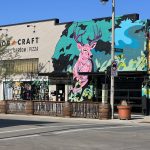What Equity Means to a Transit Rider
All the city news you can use.
Every day at The Overhead Wire we sort through over 1,500 news items about cities and share the best ones with our email list. At the end of the week, we take some of the most popular stories and share them with Urban Milwaukee readers. They are national (or international) links, sometimes entertaining and sometimes absurd, but hopefully useful.
The Gentrification font: In changing neighborhoods around the country, newer buildings with modern design are often adorned with building numbers that are in what some are calling the “gentrification font”. The “gentrification font” has been most associated with the Neutraface font, but it also includes many other san serif fonts. In addition to horizontal wood fences, the font has been documented all over social media sites like Instagram. (Bettina Makalintal | Vice)
Performative pedestrian infrastructure: In a world full of cars, most infrastructure labeled “pedestrian” is often just performative in that it was built to allow cars to go faster but doesn’t actually make walking more desirable. Pedestrian overpasses for examples are often described in glowing terms but remove pedestrians from the streets for cars. And the way they are designed to add time to a walking trip would never be allowed on streets by most engineers. (Joe Cortright | Pedestrian Observations)
Empty employment centers decimating an office economy: A trillion dollar service industry is in peril as office workers aren’t making smaller purchases at thier places of work. Airlines, coffee shops, and lunch counters all rely on central business districts and office workers to support thier businesses. So while remote work might save on the cost of the commute and office space, it could damage a part of the economy and a “galaxy of businesses” that was built up around them. (Steve LeVine | Marker)
Disability as a social and design phenomenon: Sara Hendren’s new book envisions what it would be like to change the built environment to work with the different body types of differently abled people, instead of changing bodies through prosthetics or other tools. The predominant view of disability is that it is a medical phenomenon, but what if it were seen more as a social one where our rigidly designed world moves away from what it believes to be human norms? (Katy Waldman | The New Yorker)
Quote of the Week
[Baldwin Street] might be the most COVID-friendly street in the city: big sidewalks, places to spill out onto and a nice backdrop [of residential homes]. That’s what retail in a post-COVID world should look like.
-University of Waterloo Architecture professor Val Rynnimeri in the Globe and Mail discussing how wide sidewalks can be an asset in Toronto’s during the pandemic.
This week on the podcast, Billy Fleming joins the show to talk about the life and legacy of landscape architect Ian McHarg.
Want more links to read? Visit The Overhead Wire and signup. (http://dtrnsfr.us/2iA8Yas)
Urban Reads
-
Congestion Pricing Cuts Air Pollution in New York City
 Dec 14th, 2025 by Jeff Wood
Dec 14th, 2025 by Jeff Wood
-
We Think We Love to Drive. But Do We Really?
 Dec 7th, 2025 by Jeff Wood
Dec 7th, 2025 by Jeff Wood
-
Can Scott Wiener Tackle America’s Housing Crisis?
 Nov 23rd, 2025 by Jeff Wood
Nov 23rd, 2025 by Jeff Wood





















